Stephanie Carroll's Blog: Become a VIP Reader Today!, page 4
June 29, 2016
How Charlotte Perkins Gilman's "The Yellow Wallpaper" Inspired My Novel "A White Room"
CHARLOTTE PERKINS GILMAN'S THE YELLOW WALLPAPER IN A WHITE ROOM
“The Yellow Wallpaper” is about a woman diagnosed with hysteria and confined to her bed as a form of treatment. Her doctor husband won’t allow her to do anything but rest because it was believed stimulation would worsen her condition. The story is written as if it were a journal she is sneaking as her writing was discouraged too. She keeps talking about how the only thing she can do all day is stare at this horrendous wallpaper in her room. She becomes obsessed with it, and starts seeing it move, starts seeing a woman trapped behind it.
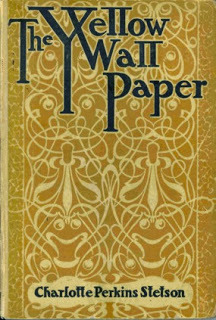 Public Domain PhotoShe goes mad, and in the last scene, she is “creeping” around the room peeling the yellow paper from the walls and laughing as everyone who had acted as her jail-keepers watches in horror. She has freed the woman behind the paper and in doing so becomes her, a wild thing freed from her bounds. Her husband faints. I interpreted this as her finding freedom through madness as she no longer cares what her husband says or what society expects.
Public Domain PhotoShe goes mad, and in the last scene, she is “creeping” around the room peeling the yellow paper from the walls and laughing as everyone who had acted as her jail-keepers watches in horror. She has freed the woman behind the paper and in doing so becomes her, a wild thing freed from her bounds. Her husband faints. I interpreted this as her finding freedom through madness as she no longer cares what her husband says or what society expects.
The first thing in A White Room that people recognize as reminiscent of “The Yellow Wallpaper” is the situation of a husband taking his wife to an isolated and disturbing country home and forcing her to rest as a form of treatment for hysteria. I re-envisioned the element of something inanimate coming to life with the house and furniture. I chose those elements instead of the wallpaper because I didn’t want to rewrite “The Yellow Wallpaper.” I wanted A White Room to stand on its own. Further, the house represents the white room in my metaphor. I wanted that white room and that white house to be the element that drove my character insane rather than the yellow wallpaper.
I incorporated the furniture after I discovered Victorian Art Nouveau. This style of furniture and decor had a lot of scrolling and winding designs that reminded me of the descriptions of the wallpaper in Gilman’s story. Plus, the designers incorporated either a life form or a suggestion of movement into every piece, so the objects practically look as though they are coming to life already. The combination of house and furniture was perfect as it embodies domesticity, which is the role and situation Emeline has been forced into.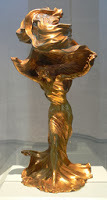 Art Nouveau sculture Loïe Fuller by François-
Art Nouveau sculture Loïe Fuller by François-
Raoul Larche (Worldwide Public Domain)
There are a variety of other more subtle elements that I took from the story, as well. The narrative is told from a limited and unreliable first-person perspective, so certain characters, like the husband, were strangers to the reader, and certain events may have occurred differently than how we are told. I used this point of view in A White Room and made Emeline's husband a stranger to the reader, at least until the very end.
The language I used in the novel is also highly inspired by “The Yellow Wallpaper.” When I reread the short story and realized I wanted to use it as my inspiration, I studied the language, assuming late 19th century vernacular would be very different from our own, but I was surprised at how modern it read. People could read this story today and think it is a contemporary piece of short fiction. It is so easy to read that I chose that route as opposed to a more flowery Victorian verbiage.
There is also a very distinctive mood created in “The Yellow Wallpaper.” It's a sense of isolation, despair, unease, and mystery characteristic of a haunted house story, but with an uncertainty of whether or not the things the main character sees are ghosts or her own hallucinations. This was one of the most complicated things to recreate. It was difficult to incite an uncertainty in the reader without causing confusion. The fact that it is not clear whether or not the house is haunted or if Emeline is seeing things is a reflection of that uncertainty in “The Yellow Wallpaper.” However, Gilman later explained that her story wasn’t meant to be a ghost story, and I can say the same thing about A White Room.
“The Yellow Wallpaper” ends with the wallpaper having driven the heroine insane, but in her madness she has discovered a sense of freedom. I still wanted my character to find freedom through insanity, but I didn’t want that to be the entire story. Instead, I made it so that Emeline is only able to pursue her passion after she goes insane because only then has she stopped caring what her husband says, what her family wants, and what society expects.
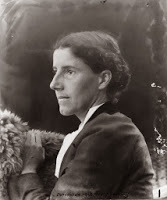 Charlotte Perkins Gilman: Public Domain PhotoWhere I really strayed from “The Yellow Wallpaper” is in the second half of the novel. My first inclination was to have Emeline leave her husband whose treatment felt so unkind, but I wanted to do something unexpected with John because when you really look at his character in “The Yellow Wallpaper,” it’s not so clear as to whether he is in fact a monster or if he is simply ignorant and insistent because of his concern for his wife. I decided I could use the unreliable narrator to go in a direction with John that was unexpected.
Charlotte Perkins Gilman: Public Domain PhotoWhere I really strayed from “The Yellow Wallpaper” is in the second half of the novel. My first inclination was to have Emeline leave her husband whose treatment felt so unkind, but I wanted to do something unexpected with John because when you really look at his character in “The Yellow Wallpaper,” it’s not so clear as to whether he is in fact a monster or if he is simply ignorant and insistent because of his concern for his wife. I decided I could use the unreliable narrator to go in a direction with John that was unexpected.
Taking the story into the underground world of unlicensed nursing and the professionalization of medicine was the biggest split from “The Yellow Wallpaper.” I went in that direction because I wanted Emeline to have the desire to seek out a profession. I wanted her to have a dream to go after once she was free to do as she pleased. I was attracted to the nursing profession because of the history of how doctors and authorities went after midwives and unlicensed nurses in a way comparable to the witch trials.
I wanted to create an interesting juxtaposition. The witch trials were a movement of mass hysteria and in response to a belief that women were naturally flawed with a weakness for evil. This is comparable to why hysteria exploded in the late 19th century. It also dealt with the belief that women were flawed, only instead of evil, it was the belief that they were vulnerable to emotional and mental instability.
Also going with a medical theme allowed me to stick with Gilman’s portrayal of the professional doctor as the enemy, but I took it in a different direction playing on other historical trends in addition to that which impacted hysteria. Further, instead of making her husband a doctor, I turned him into a lawyer for the doctors.
Sign Up for the scoop you won't find online!
“The Yellow Wallpaper” is about a woman diagnosed with hysteria and confined to her bed as a form of treatment. Her doctor husband won’t allow her to do anything but rest because it was believed stimulation would worsen her condition. The story is written as if it were a journal she is sneaking as her writing was discouraged too. She keeps talking about how the only thing she can do all day is stare at this horrendous wallpaper in her room. She becomes obsessed with it, and starts seeing it move, starts seeing a woman trapped behind it.
 Public Domain PhotoShe goes mad, and in the last scene, she is “creeping” around the room peeling the yellow paper from the walls and laughing as everyone who had acted as her jail-keepers watches in horror. She has freed the woman behind the paper and in doing so becomes her, a wild thing freed from her bounds. Her husband faints. I interpreted this as her finding freedom through madness as she no longer cares what her husband says or what society expects.
Public Domain PhotoShe goes mad, and in the last scene, she is “creeping” around the room peeling the yellow paper from the walls and laughing as everyone who had acted as her jail-keepers watches in horror. She has freed the woman behind the paper and in doing so becomes her, a wild thing freed from her bounds. Her husband faints. I interpreted this as her finding freedom through madness as she no longer cares what her husband says or what society expects.The first thing in A White Room that people recognize as reminiscent of “The Yellow Wallpaper” is the situation of a husband taking his wife to an isolated and disturbing country home and forcing her to rest as a form of treatment for hysteria. I re-envisioned the element of something inanimate coming to life with the house and furniture. I chose those elements instead of the wallpaper because I didn’t want to rewrite “The Yellow Wallpaper.” I wanted A White Room to stand on its own. Further, the house represents the white room in my metaphor. I wanted that white room and that white house to be the element that drove my character insane rather than the yellow wallpaper.
I incorporated the furniture after I discovered Victorian Art Nouveau. This style of furniture and decor had a lot of scrolling and winding designs that reminded me of the descriptions of the wallpaper in Gilman’s story. Plus, the designers incorporated either a life form or a suggestion of movement into every piece, so the objects practically look as though they are coming to life already. The combination of house and furniture was perfect as it embodies domesticity, which is the role and situation Emeline has been forced into.
 Art Nouveau sculture Loïe Fuller by François-
Art Nouveau sculture Loïe Fuller by François-Raoul Larche (Worldwide Public Domain)
There are a variety of other more subtle elements that I took from the story, as well. The narrative is told from a limited and unreliable first-person perspective, so certain characters, like the husband, were strangers to the reader, and certain events may have occurred differently than how we are told. I used this point of view in A White Room and made Emeline's husband a stranger to the reader, at least until the very end.
The language I used in the novel is also highly inspired by “The Yellow Wallpaper.” When I reread the short story and realized I wanted to use it as my inspiration, I studied the language, assuming late 19th century vernacular would be very different from our own, but I was surprised at how modern it read. People could read this story today and think it is a contemporary piece of short fiction. It is so easy to read that I chose that route as opposed to a more flowery Victorian verbiage.
There is also a very distinctive mood created in “The Yellow Wallpaper.” It's a sense of isolation, despair, unease, and mystery characteristic of a haunted house story, but with an uncertainty of whether or not the things the main character sees are ghosts or her own hallucinations. This was one of the most complicated things to recreate. It was difficult to incite an uncertainty in the reader without causing confusion. The fact that it is not clear whether or not the house is haunted or if Emeline is seeing things is a reflection of that uncertainty in “The Yellow Wallpaper.” However, Gilman later explained that her story wasn’t meant to be a ghost story, and I can say the same thing about A White Room.
“The Yellow Wallpaper” ends with the wallpaper having driven the heroine insane, but in her madness she has discovered a sense of freedom. I still wanted my character to find freedom through insanity, but I didn’t want that to be the entire story. Instead, I made it so that Emeline is only able to pursue her passion after she goes insane because only then has she stopped caring what her husband says, what her family wants, and what society expects.
 Charlotte Perkins Gilman: Public Domain PhotoWhere I really strayed from “The Yellow Wallpaper” is in the second half of the novel. My first inclination was to have Emeline leave her husband whose treatment felt so unkind, but I wanted to do something unexpected with John because when you really look at his character in “The Yellow Wallpaper,” it’s not so clear as to whether he is in fact a monster or if he is simply ignorant and insistent because of his concern for his wife. I decided I could use the unreliable narrator to go in a direction with John that was unexpected.
Charlotte Perkins Gilman: Public Domain PhotoWhere I really strayed from “The Yellow Wallpaper” is in the second half of the novel. My first inclination was to have Emeline leave her husband whose treatment felt so unkind, but I wanted to do something unexpected with John because when you really look at his character in “The Yellow Wallpaper,” it’s not so clear as to whether he is in fact a monster or if he is simply ignorant and insistent because of his concern for his wife. I decided I could use the unreliable narrator to go in a direction with John that was unexpected.Taking the story into the underground world of unlicensed nursing and the professionalization of medicine was the biggest split from “The Yellow Wallpaper.” I went in that direction because I wanted Emeline to have the desire to seek out a profession. I wanted her to have a dream to go after once she was free to do as she pleased. I was attracted to the nursing profession because of the history of how doctors and authorities went after midwives and unlicensed nurses in a way comparable to the witch trials.
I wanted to create an interesting juxtaposition. The witch trials were a movement of mass hysteria and in response to a belief that women were naturally flawed with a weakness for evil. This is comparable to why hysteria exploded in the late 19th century. It also dealt with the belief that women were flawed, only instead of evil, it was the belief that they were vulnerable to emotional and mental instability.
Also going with a medical theme allowed me to stick with Gilman’s portrayal of the professional doctor as the enemy, but I took it in a different direction playing on other historical trends in addition to that which impacted hysteria. Further, instead of making her husband a doctor, I turned him into a lawyer for the doctors.
Amazon US Review Good women's history, gripping suspense, and a great period piece. The reality of 19th-century American middle-class life for women is almost unrecognizable to us, no matter how many times we've read Little Women or Little House on the Prairie. I want everyone to read this book, and I want professors to use it in college classes. It is reminiscent of The Yellow Wallpaper by Charlotte Perkins Gilman, and A Room of One's Own by Virginia Woolf.
Sign Up for the scoop you won't find online!
Published on June 29, 2016 14:55
What is Magical Realism on Firsts in Fiction
I joined authors Aaron Gansky & Alton Gansky to discuss magical realism on the podcast Firsts in Fiction. Check it out!
Published on June 29, 2016 14:54
Excerpt from "Forget Me Not" Featured in Legacy: An Anthology
 Today Legacy: An Anthology is out! What is Legacy? Keep reading!
Today Legacy: An Anthology is out! What is Legacy? Keep reading!In January 2015, Velvet Morning Press and the The Book Wheel blogger Allison Hiltz challenged fourteen fiction and nonfiction authors to sit down, shut out distractions and write on this transcendent topic, all the while Tweeting about their efforts. The resulting fiction and nonfiction stories fill the pages of
Legacy: An Anthology.
The book includes stories from Kristopher Jansma, winner of the 2014 Sherwood Anderson Award for Fiction, New York Times best-selling author Regina Calcaterra, 2013 USA Book News Best Book Award recipient Stephanie Carroll and Canadian best-selling author Marissa Stapley among others. Read about all the contributing authors on Velvet Morning Press.
Within these pages, there is laughter, pride and hope. There is romance and rock and roll. Certain messages are eerie, while others bestow a sense of peace. The collection, through the discerning lens of each writer, runs the gamut of the human experience.
Legacy: An Anthology is available on Amazon .
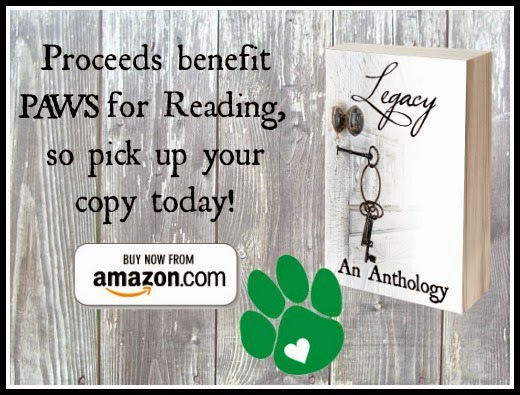 Paws for ReadingAuthor proceeds from anthology sales will be donated to
Paws for Reading
, a program that allows children to read aloud to a therapy dog (or cat, or bunny!) in order to improve reading and communication skills.
Paws for ReadingAuthor proceeds from anthology sales will be donated to
Paws for Reading
, a program that allows children to read aloud to a therapy dog (or cat, or bunny!) in order to improve reading and communication skills. 
An Excerpt from
"Forget Me Not"By Stephanie CarrollFeatured in Legacy: An Anthology
“You have to leave.”
Myrtle had me hooked by the arm, escorting me to the front door. “But you’re my sister. They’re my nieces—my nephew. I only have three days left.” She wrenched open the door and shoved me onto the front stoop. “No Lauraline, I only have three days left. Three days until this obsession and madness finally ends.” I squeezed my purse with both hands. “I just—” She pointed back into her house. “Your nieces are terrified of you. William’s crying. How could you tell them that?” “They are older than we were.” She clenched her teeth, balled up her hands. “Clearly you don’t recall what that was like.” She jabbed a finger into her chest. “I’m was older. I saw what it did to you—to all of us.” I remembered my older sisters gasping and denying it, calling Grandmamma Silvia a monster and a witch for telling an eight-year-old such a thing. “Someone had to tell them.” A part of me knew it was wrong, but I had figured Grandmamma told us against our parents’ wishes; although, she had waited until after their deaths to do so. “You are turning thirty, not ninety, and clearly you haven’t gained an ounce of wisdom in that time if you think that was appropriate.” I looked down. “Will you still come?” She crossed her arms and pursed her lips. “No. We won’t be able to attend.” I grimaced. “Don’t worry. You’ll see us again.” She narrowed her eyes. “I will be sure to come by in—not three—but four days.” I stood there on her stoop, pleading with my eyes, like I was still eight. “But—I’ll be dead.” She clenched her eyes shut and pointed out to the street. “Lauraline, just go. Please.” She shook her head. “Damn Silvia for doing this to you.” Then she slammed the door.
I rode two streetcars and then caught the train out of San Francisco back to Colma. It was about forty minutes before I spotted the milky white of carved wings, rugged pillars and monoliths, obelisks, and rows and rows of tombstones. The fog had lifted and now hovered like a wool blanket in the sky. The moisture persuaded the grass and clover to turn exceptionally green this time of year, and it flourished among the dead. The train stopped at a few cemeteries before reaching my stop. Colma is where San Francisco buries their dead. It’s a little unincorporated community just south of the city, close enough to visit by carriage, streetcar, or train. There are ten cemeteries already and talk of more because San Francisco passed an ordinance forbidding new burials within the city. All the dead come to us now. My grandfather was a sexton, and when he passed, my grandmamma said she had stayed in Colma to be closer to his whispers. Couldn’t I hear my father’s whispers, she had asked, but I never could. I walked from the station, passing three cemeteries on the way to the house my grandmamma had left me after she died. I had little other choice than to occupy it, despite my sisters’ desire for me to move to the city. I wasn’t exactly frugal with the little I earned taking down headstone engravings, so the house is of some use.
Besides, I couldn’t abandon the place where we grew up, a place that had so much of our grandmamma entwined within in its walls. That’s why I insisted if they threw a party, they had to do it at the house. They had avoided the house as much as a newcomer avoids soft soil. They’ll forget Grandmamma when it’s gone—they’ll forget me too. I stopped outside the iron-rod gate and stared at it, recalling how it felt to lay eyes on this house for the first time when I was eight years old. My parents must have avoided the house too because we did not see it until that dreadful day. To me, the house resembled a stack of decorative matchboxes stood on end, narrow and lofty as if it had wanted to rise above the clouds. A Belvedere tower loomed one level above the third story and had iron rods sticking up around the pointed roof. The doors and windows all stretched and thinned, and the wood carvings coiled and burst, manifesting puzzling ideas on the gabled pediments. I looked over my shoulder across the street at what was the edge of one of the graveyards, an area of which had been left vacant since I was a child. In the winter, the fog concealed the tombstones in the distance, and the grass and little purple forget-me-nots almost had a luminescence against the white. Just once, I told myself, just once I should go over there, but I knew I wouldn’t. I had never stepped foot in that special place, not even as a child. I turned back. After my sisters called our grandmamma a witch, I spent a lot of time hiding from her in the labyrinth that was her house. I slipped behind the secret doors in the paneling, played on the staircases inside the walls, and slinked around in the abandoned rooms. I used to skulk up the tower stairs into the attic and stare out the window, pretending that beyond the fog, the graveyard across the street was a meadow that went on forever. I used to imagine myself walking into the fog, disappearing into the endless white.

Read the Rest in Legacy: An Anthology available on Amazon.
Published on June 29, 2016 14:54
Everything You Want to Know About Magical Realism: Pt I
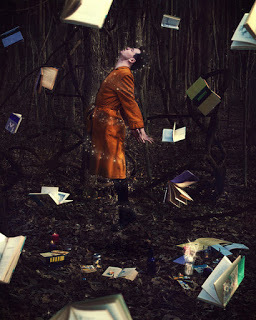 By Rachel.Adams via Flickr ccThis is one of a two-part series on Magical Realism. This article focuses on what Magical Realism is and is not.
By Rachel.Adams via Flickr ccThis is one of a two-part series on Magical Realism. This article focuses on what Magical Realism is and is not. Part II is on Using Magical Realism in Your Writing.
I decided to write this series after I was invited to discuss the topic on the Firsts in Fiction podcast (itunes - YouTube - Google+). Check out the Magical Realism Episode!
What exactly is Magical Realism?
Magical Realism or Magic Realism is a genre of fiction and film that blends magical elements with reality in a way that blurs the edges until seamless. The stories are generally but not always characterized by a unique tone and atmosphere of wonder, magic, mystery, or just a sense of strangeness.
Magical Realism is not a genre of its own because it is applied to other genres, such as romance, historical, or contemporary. By its nature, a title considered to fit within the Magical Realism genre will always be a cross-genre title.
When a work only uses a small element of Magical Realism and the other genre characteristics are so prevalent as to outweigh that element, the work would not be considered a magical realistic work, but one that uses an element or technique from Magical Realism.
As far as my knowledge and experience goes as an author of Magical Realism , I have seen two major types:
The first type is what you might call the traditional form because it is the same type originally termed Magical Realism (origin and history coming up next). This type incorporates magical elements throughout the story. These things are generally not acknowledged or explained as being magical but are treated by the author and characters as a part of reality. The magical elements are not the focus of the plot as they are not seen as significant in the characters eyes, rather they color the realistic world in a new way and create a strong sense of mood/atmosphere.
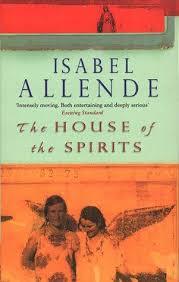 Examples include: One Hundred Years of Solitude, The Red Garden, The Girl Who Chased the Moon.
Examples include: One Hundred Years of Solitude, The Red Garden, The Girl Who Chased the Moon.The second type is seen a lot in film although there are plenty of books. It is different than the first type, but still stays in line with the definition of blending magic and reality. In this type, there is one major magical element set within our reality. Characters will respond to the element as being out of the ordinary, and it may be the focus or catalyst for the plot. Still, there is usually very little to know explanation ever discovered beyond character theories if they are given at all.
This type of Magical Realism appeared in literature before the terminology of Magical Realism came about, for example in Virginia Wolf's Orlando (1928), in which a man wakes up one day as a woman and lives for centuries without explanation.
This could lead to a lively debate about the origin of Magical Realism in European literature - or at least this type - but when it comes to scholarly discussion of Magical Realism, it is usually discussed as originating in Latin America where the term first came into use to describe elements of Latin American fiction. Thus this could also lead to a debate that this type is not Magical Realism but the sake of this series and as far as general approaches go, it generally still included because it fits the definition of blending magic and reality.
Examples include: The Green Mile, Lady in the Water, Big, fables in general.
Check out the definition from the Encyclopedia Britannica which I included below. It speaks to this debate a little. Where did Magical Realism originate from?
According to The Encyclopedia Britannica: “Magic realism, chiefly Latin-American narrative strategy that is characterized by the matter-of-fact inclusion of fantastic or mythical elements into seemingly realistic fiction. Although this strategy is known in the literature of many cultures in many ages, the term magic realism is a relatively recent designation, first applied in the 1940s by Cuban novelist Alejo Carpentier, who recognized this characteristic in much Latin-American literature. . .
"Prominent among the Latin-American magic realists are the Colombian Gabriel García Márquez, the Brazilian Jorge Amado, the Argentines Jorge Luis Borges and Julio Cortazar, and the Chilean Isabel Allende.”
Why does everyone always bring up Gabriel Garcia Marquez with Magical Realism?
Gabriel Garcia Marquez is often cited as the first or most significant Latin-American author who used Magical Realism. His most well-known works are One Hundred Years of Solitude & Love in the Time of Cholera . He was born in Columbia in 1928. One Hundred Years of Solitude was published in 1967, and in 1982, he won the Nobel Prize for literature.
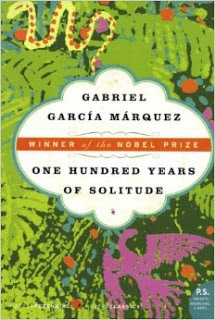
Magical Realism and Elements from Religion including Christianity and Catholicism
Despite the definition of blending magic with reality, the magical element can also be one of religious influence or origin.
For example in the story “A Very Old Man with Enormous Wings” by Gabriel García Márquez an angel falls to the earth because of a violent rainstorm. When the angel is found the characters are shocked to see an angel, and yet they never question its existence. The reality of this occurrence is never mistrusted.
Although some would argue that religion should not be consider "magical," the origin of Magical Realism is deeply ingrained in Latin American culture including prevalent religions from that area, such as Catholicism and the remnants of various pre-colonial belief systems. Native and Christian religions were blended during colonization and many native religious histories and stories were mixed with Christianity until the edges were blurred . . . ah, you see that?
According to The Encyclopedia Britannica: "Some scholars have posited that magic realism is a natural outcome of postcolonial writing, which must make sense of at least two separate realities—the reality of the conquerors as well as that of the conquered."
According to Study.com: “In Latin America, the continent from which the genre of magical realism originated, there is an attitude among certain portions of the population that anything can happen. In this way, magical realism is closely connected to the Catholic religion, which believes in miracles and other spontaneous and indescribable phenomena. The genre of magical realism is defined as a literary genre in which fantastical things are treated not just as possible, but also as realistic.”
This should not be seen as suggesting Christianity and magic are the same. Despite it's name, Magical Realism does not deal solely with magic but more with things that are in the realm of belief.
What are the differences between Magical Realism and other genres in the speculative fiction category?
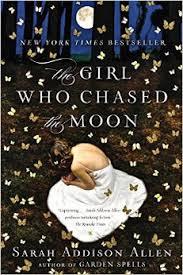 According to Wikipedia: “Speculative fiction is a broad literary genre encompassing any fiction with supernatural, fantastical, or futuristic elements, notably science fiction, fantasy and horror.”
According to Wikipedia: “Speculative fiction is a broad literary genre encompassing any fiction with supernatural, fantastical, or futuristic elements, notably science fiction, fantasy and horror.”Magical Realism is generally considered to fall under the Speculative Fiction umbrella. In fact Amazon categorizes it as a subgenre of fantasy; however, the main difference is that Magical Realism is set in a reality that is extremely similar to our own.
It is different than most stories about a haunted house or the discovery of a thousand year old vampire not by the subject but by the way it is presented. Magical and fantastical elements are presented as ordinary, plausible, and even mundane.
This might sound confusing at first because supernatural and horror stories are generally set in our reality, but it is different than Magical Realism.
For example, in a supernatural story, the discovery of a vampire often leads to the character being plunged into an alternate world where vampires exist in secret and where there is an explanation of why they exist at all, such as in Twilight and the Anne Rice Books.
In a Magical Realistic take, the discovery of a vampire might not really change anything about the characters' world and is presented in in way that blends the magical idea of a vampire with our idea of reality to the point of blurring the lines between the two, such as in Immortality with Jude Law. Last I checked, that movie is available via Netflix Instant.
Is Magical Realism the same thing as metaphysical or visionary fiction?
No, but it can be and often is blended with these genres.
Metaphysical Fiction
According to Tahlia Newland, author, editor and artist: “Where physics is a study of the nature of reality at its most subtle level, metaphysics is speculation on, or ideas about, the nature of reality. Therefore it is the philosophy or thought-provoking nature of metaphysical fiction that sets it apart from ordinary Magical Realism and supernatural fantasy.
“In the same way, a story about a ghost is not metaphysical fiction unless it explores the nature of life after death in relation to a comprehensive vision of reality.”
Visionary Fiction
According to Visionary Fiction Alliance : “Visionary Fiction embraces spiritual and esoteric wisdom, often from ancient sources, and makes it relevant for our modern life. Gems of this spiritual wisdom are brought forth in story form so that readers can experience the wisdom from within themselves. Visionary fiction emphasizes the future and envisions humanity’s transition into evolved consciousness. While there is a strong theme, it in no way proselytizes or preaches.
“Visionary is a tone as well as a genre. The ‘visionary’ element can technically be present in any genre and set in any time.”
What are some popular examples of Magical Realism in literature?
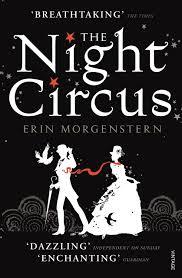 One Hundred Years of Solitude
and
Time in the Love of Cholera
- Gabriel Garcia Marquez
One Hundred Years of Solitude
and
Time in the Love of Cholera
- Gabriel Garcia MarquezPractical Magic and The Red Garden - Alice Hoffman
The Theory of Invisibility - Aimee Pita
Sugar Queen, Garden Spells, The Girl who Chased the Moon - Sarah Addison Allen
The House of the Spirits - Isabel Allende
The Library of Babel - Jorge Luis Borges
The Night Circus - Erin Morgenstern
Pretty Monsters - Kelly Link
The Secret Garden and A Little Princess - Francis Hodgson Burnett –
Wuthering Heights - Emily Bronte
Orlando - Virginia Wolf
White Teeth - Zadie Smith
Beloved - Toni Morrison
What are some popular films that make use of Magical Realism?
Many of the books above have also been made into movies but then there is:
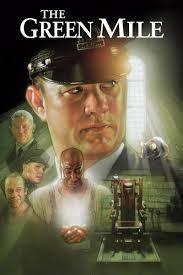
Lady in the Water by M. Night Shyamalan
Immortality (The Wisdom of Crocodiles)
Chocolat
Magnolia
The Curious Case of Benjamin Button
Moulin Rouge!
Ameile
The Green Mile
The Piano
Groundhog Day
Big
Stranger Than Fiction
Cash Back
Scholarly Non-Fiction Magical Realism Books.
Magical Realism: History, Theory, Community
Magical Realist Fiction: An Anthology
Ordinary Enchantments: Magical Realism and the Remystification of the Narrative
For more on Magical Realism and How to Use it In Your Writing, Check Out Part II on Using Magical Realism in Your Writing or check out the Firsts in Fiction Podcast!
Help me add to the list! What Magical Realism titles would you add to these?
Published on June 29, 2016 14:53
August 3, 2015
For more unhinged history . . .
I no longer actively post here at Unhinged Historian, but I still write about my historical intrigues and other shenanigans in my newsletter Coming Unhinged with Stephanie Carroll. Sign up and get free stuff!
Or check me out at my social hops, Twitter, Facebook, Pinterest, Instagram, Goodreads, not to mention the old website www.stephaniecarroll.net. Hope to see you around!
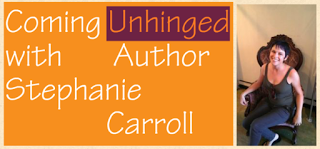
Upon Sign Up You Will Receive: An autograph from William Kemmler, the first man to die in the electric chair.
A picture of the house that inspired the house in A White Room.
Excerpts from Thomas Edison's testimony on the death by electrocution law.
A 19th Century article on the latest fashions in Victorian hairstyles.
Pictures of Art Nouveau deco, which inspired the furniture in A White Room.
Instructions to receive the first chapter of A White Room on your kindle for FREE!
A FREE edition of Authors on Authorship & Publishing featuring Nanette Field, Amy Bird, and Stephanie Carroll on writing and publishing.
Plus With Unhinged Newsletters you get the opportunity to read free Sample Chapters, Deleted Scenes, Character Histories, Novel Research, Author Reads, About the Author, and of course . . .You Will Be the First to hear about New Releases, VIP Only Giveaways, & Discounts! #mc_embed_signup{background:#fff; clear:left; font:14px Helvetica,Arial,sans-serif; } /* Add your own MailChimp form style overrides in your site stylesheet or in this style block. We recommend moving this block and the preceding CSS link to the HEAD of your HTML file. */
Or check me out at my social hops, Twitter, Facebook, Pinterest, Instagram, Goodreads, not to mention the old website www.stephaniecarroll.net. Hope to see you around!

Upon Sign Up You Will Receive: An autograph from William Kemmler, the first man to die in the electric chair.
A picture of the house that inspired the house in A White Room.
Excerpts from Thomas Edison's testimony on the death by electrocution law.
A 19th Century article on the latest fashions in Victorian hairstyles.
Pictures of Art Nouveau deco, which inspired the furniture in A White Room.
Instructions to receive the first chapter of A White Room on your kindle for FREE!
A FREE edition of Authors on Authorship & Publishing featuring Nanette Field, Amy Bird, and Stephanie Carroll on writing and publishing.
Plus With Unhinged Newsletters you get the opportunity to read free Sample Chapters, Deleted Scenes, Character Histories, Novel Research, Author Reads, About the Author, and of course . . .You Will Be the First to hear about New Releases, VIP Only Giveaways, & Discounts! #mc_embed_signup{background:#fff; clear:left; font:14px Helvetica,Arial,sans-serif; } /* Add your own MailChimp form style overrides in your site stylesheet or in this style block. We recommend moving this block and the preceding CSS link to the HEAD of your HTML file. */
Published on August 03, 2015 21:15
January 13, 2014
Become a VIP Reader Today!
Sign Up Now!
1. Be the First to Know About Free-bees, Giveaways, and Discounts in addition to receiving Email List Only Deals and Prizes!
2. Read Behind the Scenes Material from Published & In-Progress Books and Provide Feedback!
3. Get the Chance to Become a Test Reader and Receive an Advanced Copy for Free!
4. Be the First to Know About New Releases!
5. Learn more about me and my books, while also learning the how-tos of writing and publishing through my experiences.
Sign Up Now!
Email Address
1. Be the First to Know About Free-bees, Giveaways, and Discounts in addition to receiving Email List Only Deals and Prizes!
2. Read Behind the Scenes Material from Published & In-Progress Books and Provide Feedback!
3. Get the Chance to Become a Test Reader and Receive an Advanced Copy for Free!
4. Be the First to Know About New Releases!
5. Learn more about me and my books, while also learning the how-tos of writing and publishing through my experiences.
Sign Up Now!
Email Address
Published on January 13, 2014 08:28
October 30, 2013
Halloween History: Victorian Halloween Party Decorations & Games from 1903 Newspaper Article
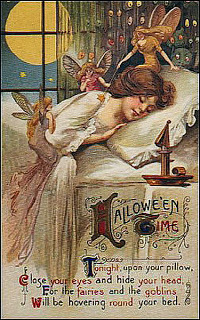 Public Domain ImageToday's Halloween History guest post is via Arra Abella's Style Reader, a very cute and posh book review blog. This was by far my absolute favorite guest post for this Halloween tour and it's also the final post in the tour so I saved the best for last. Enjoy!
Public Domain ImageToday's Halloween History guest post is via Arra Abella's Style Reader, a very cute and posh book review blog. This was by far my absolute favorite guest post for this Halloween tour and it's also the final post in the tour so I saved the best for last. Enjoy!Don't forget the Halloween tour was to promote my Gothic Victorian novel A White Room being on sale for $0.99 cents until Oct. 31, 2013 and my big Halloween Giveaway ending Oct. 31, 2013
Here is your teaser, but you will have to click on over to Style Reader to read the rest.
The following turn of the century Halloween festivities were taken from two articles in the October 25, 1903 edition of The Sunday Herald of Syracuse, New York. The first article is titled “Halloween: Unique and Ghost-Like Decorations” and is an account of a Halloween party for adults, focusing specifically on the decorations.
The second article was titled “Halloween: What to do on this Witching Eve,” and is an instruction for a witch themed party for young unmarried girls. It includes detailed descriptions of Halloween “charms” or what we would call spells, most of which were designed to determine the girls’ future husbands.
Victorian Halloween Decorations for a Turn of the Century Party The writer of the article explained that this was a party he actually attended, and it is given from his perspective. When he asked the hostess where she got the ideas for the decorations, she said she had thought them up on the spur of the moment.
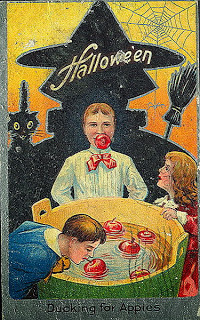 Public Domain PhotoOutside of the house, yellow jack-o-lanterns and squash hung from plazas. They included a lamp and had eyes, noses, and grins carved into them. The author of this article writes about the jack-o-lantern faces in a way that suggests it may have been a novelty, at least to him.
Public Domain PhotoOutside of the house, yellow jack-o-lanterns and squash hung from plazas. They included a lamp and had eyes, noses, and grins carved into them. The author of this article writes about the jack-o-lantern faces in a way that suggests it may have been a novelty, at least to him.Just at the door stood a tall wooden figure draped in black sheets. It had red eyes, a nose, and a grinning mouth. The author commented that the figure “suspiciously looked like a photographer’s lantern on a jag.” Chains bound the hands of the figure and also hung from the door, making it rattle as guests entered the house.
Inside, the only light came from green flames burning in tin plates. The flame came from alcohol sitting on a bed of salts. The writer commented that the flames made the guests’ faces glow green, a color that was “subconsciously associated with ghosts.” Inside the library there were ...
Click on over to Style Reader to finish reading about the decorations. The Halloween games for young unmarried girls is coming up too! That is really interesting to read about even if it isn't something you would want to do at your party.
Published on October 30, 2013 08:15
October 29, 2013
Victorian Mourning Etiquette Secrets: The Forgotten Traditions & Explanations for Victorian Mourning
Today's Halloween History guest posts are on Chapter Break and Psychotic State, two really wonderful book review blogs that I highly recommend you follow to discover the best reads. I wrote both of these posts with the idea that there are articles all over the Internet about Victorian Mourning, so I focused on the lesser known history, the stuff that other posts don't always have.
Chapter Break: This post is on why Victorians had mourning etiquette in the first place, which is something I rarely see in other articles. Other posts usually focus on the etiquette itself. This is about where it came from and why it was so popular. No, it's not just Queen Victoria. That was actually only a small factor.
Psychotic State: This post is about the etiquette itself, but with more emphasis on the aspects that you don't read about as often, so there is less info on Memento Mori and Hair Jewelry but more history on other traditions and mentalities. I put the lesser known facts in Bold because I couldn't separate them from the well known facts that usually get a lot of attention. The items in bold are the details that often times get left out.
BTW, these posts were inspired by and elaborated from my very popular post from a year or so ago called Why Victorians were Obsessed with Death. So if you liked that, you should really enjoy these.
Don't forget it's all a part of my Halloween Celebration which includes the Giveaway ending Oct. 31, 2013 and my Gothic Victorian novel A White Room on sale for 0.99 cents until Oct. 31, 2013.
First a little teaser from Chapter Break then one from Psychotic State. You'll have to visit those blogs for the full shebang! Don't forget to comment or ask questions if there's something you'd like to have a little more elaboration on! and Enjoy!
Halloween History: Little Known Reasons Why Victorians Had Mourning Etiquette
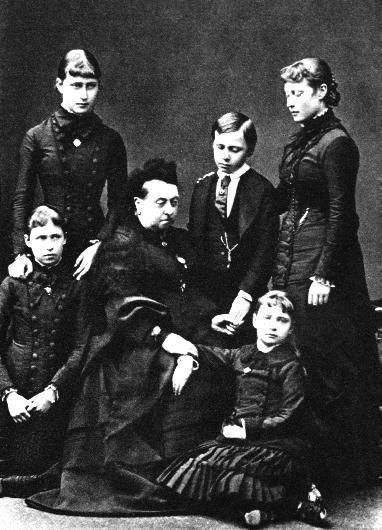 The Victorian Gothic is a common theme during Halloween because 19thcentury society was obsessed with death. In the late 1800s and early 1900s, people had dramatic displays and etiquette to respond to a death in what is often called the Victorian Cult of the Dead. This culture and etiquette included black clothing, photos of the deceased, hair jewelry, séances, and preventative measures in case someone was buried alive! Much of this etiquette is described in detail all over the internet, so today I want to focus more on why the Victorians developed this culture.FashionThe United Kingdom monarch, Queen Victoria, sparked the creation of mourning culture after her beloved husband Prince Albert died at the age of 42 in 1861. For the next 40 years, the queen wore black and froze her house in time, having servants continue to lay out her husband’s clothing daily. Just as fashion from Paris is in vogue in America, so too was a queen’s mourning practices, which became the popular etiquette all over the world.EconomicsThe more elaborate each step of the funeral and burial, the more it showed the family loved and adored the deceased, so people were encouraged to purchase the most expensive coffins, elaborate head stones, mausoleums, and family plots, in addition to flowers, special clothing, and memorabilia including post mortem photography known as Memento Moriand specially made hair jewelry with locks of hair from the dead.
The Victorian Gothic is a common theme during Halloween because 19thcentury society was obsessed with death. In the late 1800s and early 1900s, people had dramatic displays and etiquette to respond to a death in what is often called the Victorian Cult of the Dead. This culture and etiquette included black clothing, photos of the deceased, hair jewelry, séances, and preventative measures in case someone was buried alive! Much of this etiquette is described in detail all over the internet, so today I want to focus more on why the Victorians developed this culture.FashionThe United Kingdom monarch, Queen Victoria, sparked the creation of mourning culture after her beloved husband Prince Albert died at the age of 42 in 1861. For the next 40 years, the queen wore black and froze her house in time, having servants continue to lay out her husband’s clothing daily. Just as fashion from Paris is in vogue in America, so too was a queen’s mourning practices, which became the popular etiquette all over the world.EconomicsThe more elaborate each step of the funeral and burial, the more it showed the family loved and adored the deceased, so people were encouraged to purchase the most expensive coffins, elaborate head stones, mausoleums, and family plots, in addition to flowers, special clothing, and memorabilia including post mortem photography known as Memento Moriand specially made hair jewelry with locks of hair from the dead.
The funeral business was a huge industry. Many historians believe much of the encouragement to mourn excessively came from the industry’s desire to make money off of the grieving. These historians believe the industry found ways to guilt people into the expensive practices. However, other historians argue that the crossover of mourning to different cultural signposts, such as literature, suggests the practice went deeper than aneconomic and fashionable trend.
Psychology: Coping with DeathWithout modern medicine, the average lifespan was much shorter than it is today, and hospitals could be dangerous due to a lack of knowledge about infection. Thus, people died regularly and died in the home where loved ones witnessed ...
This is where it really gets good so go read the rest of the post on Chapter Break!
Victorian Gothic: Victorian Mourning Etiquette and Mentality with a Focus on the Lesser Known Aspects!
Victorian mourning etiquette consisted of a large set of traditions and expectations that were considered an appropriate way to mourn a death; however, behind the outward expressions of mourning, there were anxieties and struggles going on in the deeper psychology of the Victorian society. Victorian Mourning customs are all over the internet, but this article includes little known facts that have been bolded for your convenience.It’s important to keep in mind that the stages of mourning were different depending on the specific point in the century. Further, Victorian mourning could vary quite a lot from Europe to America and even from one coast to the other. Mourning traditions grew popular out of the United Kingdom after Queen Victoriawent into deep mourning when her beloved husband, Prince Albert, died in 1861 at the age of 42. Some customs were less strict or elaborate once they reached America. However, there were some overall traditions that remained relatively the same. The Death Death was common during the Victorian Era. A large percentage of babies and children died as well as adults. It was a frightening thing as new discoveries about human death spurred more questions than answers. It wasn’t clear if death occurred due the heart stopping or the brain dying and why these things occurred at all. This uncertainty led to a fear that people could be buried or dissected alive.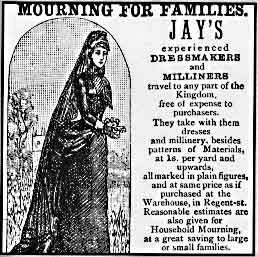 It also led to fears regarding what it meant about the soul if brain death was the ultimate cause of death. People believed the soul resided within the heart or chest cavity, so it made sense that the heart stopping signaled death as this would mean the release of the soul, but if it was the brain, then what did that mean about the soul? Various advancements in knowledge and technology ultimately created fears over the
existence of the soul and life after death
, which is why Victorians were also quite obsessed with
ghosts, séances, and spiritualism
.
It also led to fears regarding what it meant about the soul if brain death was the ultimate cause of death. People believed the soul resided within the heart or chest cavity, so it made sense that the heart stopping signaled death as this would mean the release of the soul, but if it was the brain, then what did that mean about the soul? Various advancements in knowledge and technology ultimately created fears over the
existence of the soul and life after death
, which is why Victorians were also quite obsessed with
ghosts, séances, and spiritualism
.
Unlike modern times, death most commonly occurred within the home in result of an illness. Lack of medicine and the use of family members to care for the ill meant that all the messy and difficult parts of an illness were witnessed by the direct relatives. Further, the byproducts of the human body ceasing to function were witnessed and cleaned by family members or by servants in an upper class home. Historians have interpreted the elaborate spectacles surrounding death as a way for people to deal with and overcome the most disturbing and traumatizing realities of death in Victorian society. The Funeral and Burial The funerals and burials of the deceased were elaborate shows put on by a family even at their own financial detriment. People considered the bigger and better the funeral, the more the departed had been loved, so many would go above and beyond to prove their affections.The funeral could take place in the home or in a church. People might have a friend of the family sit with the dead for a time or have a waiting mortuary to delay the burial in case of a misdiagnosed death. In the home, there might be a viewing, but not usually in a church unless it was for a very prominent man who would attract more mourners than a house could accommodate. Sometimes people would send out an announcement that the funereal was private to deter a large attendance, but if someone did show up, no one would turn him or her away.A family might hire a normal horse-drawn hearse or one with a glass cover so people could see inside. Carriages and mourners would follow behind the hearse in a dramatic precession down public streets to the cemetery. The family might also hire carriages for some of the attendees, and some families even hired mourners or “mutes” to walk behind the hearse in the procession.Of course the more elaborate each step of the funeral and burial, the better, so families were encouraged to purchase the most expensive coffins, elaborate head stones, mausoleums, and family plots. Further, people would buy large amount of flowers, mourning wardrobes, memorabilia including post mortem photos, known as Memento Mori, and hair jewelry made with locks of hair from the deceased.The funeral business was a huge industry. Many historians believe the popularity of extravagance in funerals originated from the industry’s desire to make money off of the grieving. However, some historians argue that the crossover of extravagant mourning to other aspects of Victorian culture, such as literature, suggests it was much deeper than an economic and fashionable trend . Inside The Home The home was prepared after a death to be a quiet, dark solitude of grief. Victorians would cover the mirrors with black sheaths because women were not supposed to partake in any kind of vanity during this time as they should look dreadful from weeping. Someone would drape a piece of black velvet over the portrait of the patriarch if he had passed. They also locked the piano because no one was to play any music, and there would be no dinner parties or festivities in the house for some time. Sometimes other areas of the home were also draped or decorated with black fabric. They would drape the family carriage with black velvet too.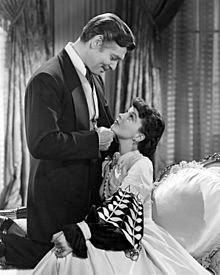 There were a variety of traditions to signal outsiders that the house was in mourning. Some people hung black wreaths on the door, or the family covered the doorknobs in white crepe for a child’s death or black crepe for an adult’s death.Markers like these signaled to visitors that they should prepare to speak quietly and quickly so they do not overtax or burden the bereaved. The family might also muffle the doorbell to prevent any loud noises, which would startle the already anxious nerves of those inside. Oftentimes, people would not call upon a family in mourning unless they were close friends or relatives.
Public Appearances
Although it wasn’t unheard of to forgo mourning, most people abided by the customs as a sign of sorrow and respect for the dead, especially women and widows in particular. The expectations of mourning were less severe on ...
There were a variety of traditions to signal outsiders that the house was in mourning. Some people hung black wreaths on the door, or the family covered the doorknobs in white crepe for a child’s death or black crepe for an adult’s death.Markers like these signaled to visitors that they should prepare to speak quietly and quickly so they do not overtax or burden the bereaved. The family might also muffle the doorbell to prevent any loud noises, which would startle the already anxious nerves of those inside. Oftentimes, people would not call upon a family in mourning unless they were close friends or relatives.
Public Appearances
Although it wasn’t unheard of to forgo mourning, most people abided by the customs as a sign of sorrow and respect for the dead, especially women and widows in particular. The expectations of mourning were less severe on ...
Find out who the expectations were less severe on at Psychotic State!
Chapter Break: This post is on why Victorians had mourning etiquette in the first place, which is something I rarely see in other articles. Other posts usually focus on the etiquette itself. This is about where it came from and why it was so popular. No, it's not just Queen Victoria. That was actually only a small factor.
Psychotic State: This post is about the etiquette itself, but with more emphasis on the aspects that you don't read about as often, so there is less info on Memento Mori and Hair Jewelry but more history on other traditions and mentalities. I put the lesser known facts in Bold because I couldn't separate them from the well known facts that usually get a lot of attention. The items in bold are the details that often times get left out.
BTW, these posts were inspired by and elaborated from my very popular post from a year or so ago called Why Victorians were Obsessed with Death. So if you liked that, you should really enjoy these.
Don't forget it's all a part of my Halloween Celebration which includes the Giveaway ending Oct. 31, 2013 and my Gothic Victorian novel A White Room on sale for 0.99 cents until Oct. 31, 2013.
First a little teaser from Chapter Break then one from Psychotic State. You'll have to visit those blogs for the full shebang! Don't forget to comment or ask questions if there's something you'd like to have a little more elaboration on! and Enjoy!
Halloween History: Little Known Reasons Why Victorians Had Mourning Etiquette
 The Victorian Gothic is a common theme during Halloween because 19thcentury society was obsessed with death. In the late 1800s and early 1900s, people had dramatic displays and etiquette to respond to a death in what is often called the Victorian Cult of the Dead. This culture and etiquette included black clothing, photos of the deceased, hair jewelry, séances, and preventative measures in case someone was buried alive! Much of this etiquette is described in detail all over the internet, so today I want to focus more on why the Victorians developed this culture.FashionThe United Kingdom monarch, Queen Victoria, sparked the creation of mourning culture after her beloved husband Prince Albert died at the age of 42 in 1861. For the next 40 years, the queen wore black and froze her house in time, having servants continue to lay out her husband’s clothing daily. Just as fashion from Paris is in vogue in America, so too was a queen’s mourning practices, which became the popular etiquette all over the world.EconomicsThe more elaborate each step of the funeral and burial, the more it showed the family loved and adored the deceased, so people were encouraged to purchase the most expensive coffins, elaborate head stones, mausoleums, and family plots, in addition to flowers, special clothing, and memorabilia including post mortem photography known as Memento Moriand specially made hair jewelry with locks of hair from the dead.
The Victorian Gothic is a common theme during Halloween because 19thcentury society was obsessed with death. In the late 1800s and early 1900s, people had dramatic displays and etiquette to respond to a death in what is often called the Victorian Cult of the Dead. This culture and etiquette included black clothing, photos of the deceased, hair jewelry, séances, and preventative measures in case someone was buried alive! Much of this etiquette is described in detail all over the internet, so today I want to focus more on why the Victorians developed this culture.FashionThe United Kingdom monarch, Queen Victoria, sparked the creation of mourning culture after her beloved husband Prince Albert died at the age of 42 in 1861. For the next 40 years, the queen wore black and froze her house in time, having servants continue to lay out her husband’s clothing daily. Just as fashion from Paris is in vogue in America, so too was a queen’s mourning practices, which became the popular etiquette all over the world.EconomicsThe more elaborate each step of the funeral and burial, the more it showed the family loved and adored the deceased, so people were encouraged to purchase the most expensive coffins, elaborate head stones, mausoleums, and family plots, in addition to flowers, special clothing, and memorabilia including post mortem photography known as Memento Moriand specially made hair jewelry with locks of hair from the dead.The funeral business was a huge industry. Many historians believe much of the encouragement to mourn excessively came from the industry’s desire to make money off of the grieving. These historians believe the industry found ways to guilt people into the expensive practices. However, other historians argue that the crossover of mourning to different cultural signposts, such as literature, suggests the practice went deeper than aneconomic and fashionable trend.
Psychology: Coping with DeathWithout modern medicine, the average lifespan was much shorter than it is today, and hospitals could be dangerous due to a lack of knowledge about infection. Thus, people died regularly and died in the home where loved ones witnessed ...
This is where it really gets good so go read the rest of the post on Chapter Break!
Victorian Gothic: Victorian Mourning Etiquette and Mentality with a Focus on the Lesser Known Aspects!
Victorian mourning etiquette consisted of a large set of traditions and expectations that were considered an appropriate way to mourn a death; however, behind the outward expressions of mourning, there were anxieties and struggles going on in the deeper psychology of the Victorian society. Victorian Mourning customs are all over the internet, but this article includes little known facts that have been bolded for your convenience.It’s important to keep in mind that the stages of mourning were different depending on the specific point in the century. Further, Victorian mourning could vary quite a lot from Europe to America and even from one coast to the other. Mourning traditions grew popular out of the United Kingdom after Queen Victoriawent into deep mourning when her beloved husband, Prince Albert, died in 1861 at the age of 42. Some customs were less strict or elaborate once they reached America. However, there were some overall traditions that remained relatively the same. The Death Death was common during the Victorian Era. A large percentage of babies and children died as well as adults. It was a frightening thing as new discoveries about human death spurred more questions than answers. It wasn’t clear if death occurred due the heart stopping or the brain dying and why these things occurred at all. This uncertainty led to a fear that people could be buried or dissected alive.
 It also led to fears regarding what it meant about the soul if brain death was the ultimate cause of death. People believed the soul resided within the heart or chest cavity, so it made sense that the heart stopping signaled death as this would mean the release of the soul, but if it was the brain, then what did that mean about the soul? Various advancements in knowledge and technology ultimately created fears over the
existence of the soul and life after death
, which is why Victorians were also quite obsessed with
ghosts, séances, and spiritualism
.
It also led to fears regarding what it meant about the soul if brain death was the ultimate cause of death. People believed the soul resided within the heart or chest cavity, so it made sense that the heart stopping signaled death as this would mean the release of the soul, but if it was the brain, then what did that mean about the soul? Various advancements in knowledge and technology ultimately created fears over the
existence of the soul and life after death
, which is why Victorians were also quite obsessed with
ghosts, séances, and spiritualism
.
Unlike modern times, death most commonly occurred within the home in result of an illness. Lack of medicine and the use of family members to care for the ill meant that all the messy and difficult parts of an illness were witnessed by the direct relatives. Further, the byproducts of the human body ceasing to function were witnessed and cleaned by family members or by servants in an upper class home. Historians have interpreted the elaborate spectacles surrounding death as a way for people to deal with and overcome the most disturbing and traumatizing realities of death in Victorian society. The Funeral and Burial The funerals and burials of the deceased were elaborate shows put on by a family even at their own financial detriment. People considered the bigger and better the funeral, the more the departed had been loved, so many would go above and beyond to prove their affections.The funeral could take place in the home or in a church. People might have a friend of the family sit with the dead for a time or have a waiting mortuary to delay the burial in case of a misdiagnosed death. In the home, there might be a viewing, but not usually in a church unless it was for a very prominent man who would attract more mourners than a house could accommodate. Sometimes people would send out an announcement that the funereal was private to deter a large attendance, but if someone did show up, no one would turn him or her away.A family might hire a normal horse-drawn hearse or one with a glass cover so people could see inside. Carriages and mourners would follow behind the hearse in a dramatic precession down public streets to the cemetery. The family might also hire carriages for some of the attendees, and some families even hired mourners or “mutes” to walk behind the hearse in the procession.Of course the more elaborate each step of the funeral and burial, the better, so families were encouraged to purchase the most expensive coffins, elaborate head stones, mausoleums, and family plots. Further, people would buy large amount of flowers, mourning wardrobes, memorabilia including post mortem photos, known as Memento Mori, and hair jewelry made with locks of hair from the deceased.The funeral business was a huge industry. Many historians believe the popularity of extravagance in funerals originated from the industry’s desire to make money off of the grieving. However, some historians argue that the crossover of extravagant mourning to other aspects of Victorian culture, such as literature, suggests it was much deeper than an economic and fashionable trend . Inside The Home The home was prepared after a death to be a quiet, dark solitude of grief. Victorians would cover the mirrors with black sheaths because women were not supposed to partake in any kind of vanity during this time as they should look dreadful from weeping. Someone would drape a piece of black velvet over the portrait of the patriarch if he had passed. They also locked the piano because no one was to play any music, and there would be no dinner parties or festivities in the house for some time. Sometimes other areas of the home were also draped or decorated with black fabric. They would drape the family carriage with black velvet too.
 There were a variety of traditions to signal outsiders that the house was in mourning. Some people hung black wreaths on the door, or the family covered the doorknobs in white crepe for a child’s death or black crepe for an adult’s death.Markers like these signaled to visitors that they should prepare to speak quietly and quickly so they do not overtax or burden the bereaved. The family might also muffle the doorbell to prevent any loud noises, which would startle the already anxious nerves of those inside. Oftentimes, people would not call upon a family in mourning unless they were close friends or relatives.
Public Appearances
Although it wasn’t unheard of to forgo mourning, most people abided by the customs as a sign of sorrow and respect for the dead, especially women and widows in particular. The expectations of mourning were less severe on ...
There were a variety of traditions to signal outsiders that the house was in mourning. Some people hung black wreaths on the door, or the family covered the doorknobs in white crepe for a child’s death or black crepe for an adult’s death.Markers like these signaled to visitors that they should prepare to speak quietly and quickly so they do not overtax or burden the bereaved. The family might also muffle the doorbell to prevent any loud noises, which would startle the already anxious nerves of those inside. Oftentimes, people would not call upon a family in mourning unless they were close friends or relatives.
Public Appearances
Although it wasn’t unheard of to forgo mourning, most people abided by the customs as a sign of sorrow and respect for the dead, especially women and widows in particular. The expectations of mourning were less severe on ...
Find out who the expectations were less severe on at Psychotic State!
Published on October 29, 2013 09:47
October 28, 2013
Halloween History & Haunted Houses: What Makes Victorian Houses Look & Feel Haunted
Happy to announce that my Gothic Victorian novel
A White Room
reached #1 over the weekend! YAY!!! It's still on sale for $.99 until October 31 (2013) so if you haven't yet, get on over there or tell a friend or something. ;)
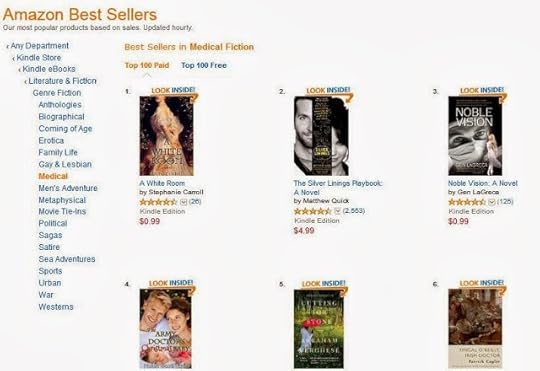
Also a part of this promotion, I am writing Halloween History guest posts all over the internet. Below is a little preview of what I got going on over at Country House Reader! Dude I am loving this blog. It's all about historical country houses and historical preservation. It's a really academic and professional blog. The gal who writes it, Julie Day, really is an expert in her field. No literally, she had a Ph.D. in 18th Century history, an a particular expertise for buildings, architecture, material culture, servants, and estate management. Really cool stuff.
She was kind enough to let me write a post on her blog all about why some Victorian houses look scary and why they can feel eerie too! Thank you Julie! Click on over to Julie's blog to read the entire thing.
How is it that some Victorian houses are the cutest darn things you’ve ever seen and some are right out of a Gothic horror story? It’s not as simple as adding dark colors. There are particular styles, cultural symbols, and historical associations which make some Victorian houses scarier than others.ArchitectureThere are several different types of Victorian architecture. Some like Queen Anne houses, Greek-Revivals, and Italianates are really cute, usually painted in pastel colors, and represent refined prominence and achievement. There are probably some houses in these styles that one could say look creepy, but that is usually due to deterioration as opposed to the original appearance. The two types of Victorian houses that seemingly represent the quintessential haunted house are designed in either the Gothic Revival or Second Empire styles. Gothic Revivals are literally a throwback to the Gothic castles and churches of the medieval period, and include steep or peeked rooftops, arches, pinnacles, and decorative ornamentation especially over and around windows. Arches were also popular for entryways, doorways, porches, windows, etc. Sometimes these types of houses will have a lot of height to them or may include a large tower.The original Gothic horror stories were all set in or around decaying Gothic churches or castles from medieval times and the architectural style became a worldwide symbol of the horror genre. The look of Gothic architecture is culturally embedded into our minds as a symbol of something dreadful and sinister. Nineteenth-century writers developed this further within literature as the Gothic genre evolved new tactics for creating fear. Gothic Revival houses and mansions not only look reminiscent of the horror story castles, but they became a fundamental setting for Victorian Gothic literature . Recognizable symbols of Gothic literature still commonly populate modern day horror genres. Second Empire architecture was inspired by the reconstruction of Paris, France under the direction of Napoleon III who had much of the city torn down and rebuilt with wider roads and large elaborate buildings. Victorian Second Empire houses are usually very large and ornate, with lots of floors and windows. They are styled in a box shape with mansard roofs and often include a foreboding tower as a focal point. Some people have said the squared levels and roofs make these houses resemble stacked boxes or a tiered cake. Second Empire houses have been used in twentieth century Halloween and horror movies includingPsycho, The Adams Family, and Beetlejuice.Interior DesignVictorian f
loor plans
were designed so that each room came off a central hallway and but were closed off from other rooms. The small enclosed space was easier ....Read the rest at Country House Reader!
Second Empire architecture was inspired by the reconstruction of Paris, France under the direction of Napoleon III who had much of the city torn down and rebuilt with wider roads and large elaborate buildings. Victorian Second Empire houses are usually very large and ornate, with lots of floors and windows. They are styled in a box shape with mansard roofs and often include a foreboding tower as a focal point. Some people have said the squared levels and roofs make these houses resemble stacked boxes or a tiered cake. Second Empire houses have been used in twentieth century Halloween and horror movies includingPsycho, The Adams Family, and Beetlejuice.Interior DesignVictorian f
loor plans
were designed so that each room came off a central hallway and but were closed off from other rooms. The small enclosed space was easier ....Read the rest at Country House Reader!
Don't Forget My Halloween Giveaway Ends this Thursday on Oct. 31!!!

Also a part of this promotion, I am writing Halloween History guest posts all over the internet. Below is a little preview of what I got going on over at Country House Reader! Dude I am loving this blog. It's all about historical country houses and historical preservation. It's a really academic and professional blog. The gal who writes it, Julie Day, really is an expert in her field. No literally, she had a Ph.D. in 18th Century history, an a particular expertise for buildings, architecture, material culture, servants, and estate management. Really cool stuff.
She was kind enough to let me write a post on her blog all about why some Victorian houses look scary and why they can feel eerie too! Thank you Julie! Click on over to Julie's blog to read the entire thing.
How is it that some Victorian houses are the cutest darn things you’ve ever seen and some are right out of a Gothic horror story? It’s not as simple as adding dark colors. There are particular styles, cultural symbols, and historical associations which make some Victorian houses scarier than others.ArchitectureThere are several different types of Victorian architecture. Some like Queen Anne houses, Greek-Revivals, and Italianates are really cute, usually painted in pastel colors, and represent refined prominence and achievement. There are probably some houses in these styles that one could say look creepy, but that is usually due to deterioration as opposed to the original appearance. The two types of Victorian houses that seemingly represent the quintessential haunted house are designed in either the Gothic Revival or Second Empire styles. Gothic Revivals are literally a throwback to the Gothic castles and churches of the medieval period, and include steep or peeked rooftops, arches, pinnacles, and decorative ornamentation especially over and around windows. Arches were also popular for entryways, doorways, porches, windows, etc. Sometimes these types of houses will have a lot of height to them or may include a large tower.The original Gothic horror stories were all set in or around decaying Gothic churches or castles from medieval times and the architectural style became a worldwide symbol of the horror genre. The look of Gothic architecture is culturally embedded into our minds as a symbol of something dreadful and sinister. Nineteenth-century writers developed this further within literature as the Gothic genre evolved new tactics for creating fear. Gothic Revival houses and mansions not only look reminiscent of the horror story castles, but they became a fundamental setting for Victorian Gothic literature . Recognizable symbols of Gothic literature still commonly populate modern day horror genres.
 Second Empire architecture was inspired by the reconstruction of Paris, France under the direction of Napoleon III who had much of the city torn down and rebuilt with wider roads and large elaborate buildings. Victorian Second Empire houses are usually very large and ornate, with lots of floors and windows. They are styled in a box shape with mansard roofs and often include a foreboding tower as a focal point. Some people have said the squared levels and roofs make these houses resemble stacked boxes or a tiered cake. Second Empire houses have been used in twentieth century Halloween and horror movies includingPsycho, The Adams Family, and Beetlejuice.Interior DesignVictorian f
loor plans
were designed so that each room came off a central hallway and but were closed off from other rooms. The small enclosed space was easier ....Read the rest at Country House Reader!
Second Empire architecture was inspired by the reconstruction of Paris, France under the direction of Napoleon III who had much of the city torn down and rebuilt with wider roads and large elaborate buildings. Victorian Second Empire houses are usually very large and ornate, with lots of floors and windows. They are styled in a box shape with mansard roofs and often include a foreboding tower as a focal point. Some people have said the squared levels and roofs make these houses resemble stacked boxes or a tiered cake. Second Empire houses have been used in twentieth century Halloween and horror movies includingPsycho, The Adams Family, and Beetlejuice.Interior DesignVictorian f
loor plans
were designed so that each room came off a central hallway and but were closed off from other rooms. The small enclosed space was easier ....Read the rest at Country House Reader!Don't Forget My Halloween Giveaway Ends this Thursday on Oct. 31!!!
Published on October 28, 2013 09:36
October 19, 2013
Halloween History: Gothic Horror Story or Victorian Woman’s Reality?
 Victorian Gothic Author Essie FoxAlthough I am taking a break from doing my regular blog posts, I am going to be posting links to some of the awesome guest posts I'm doing to promote my Halloween $0.99 cent sale of A White Room. They are all very Unhinged Historian type stuff, so enjoy the posts and enjoy getting to see some new blogs out there that are totally your style. If you like this whacked out blog, then you will love these blogs which are way nicer than this one in my opinion. =)
Victorian Gothic Author Essie FoxAlthough I am taking a break from doing my regular blog posts, I am going to be posting links to some of the awesome guest posts I'm doing to promote my Halloween $0.99 cent sale of A White Room. They are all very Unhinged Historian type stuff, so enjoy the posts and enjoy getting to see some new blogs out there that are totally your style. If you like this whacked out blog, then you will love these blogs which are way nicer than this one in my opinion. =)Today, I want you to check out Victorian Gothic author Essie Fox's website (it's one of the best website designs I've seen BTW) and blog The Virtual Victorian where she has kindly let me post about the historical context of the Victorian Gothic short story "The Yellow Wallpaper" written by Charlotte Perkins Gilman in the late 1890s. Some people read the story and think it's just horror, but they don't realize it's actually a feminist message regarding women's status in the Victorian Era and the flawed beliefs surrounding Hysteria. This isn't a run of the mill going over the basics either. It's an in depth article on the topic.
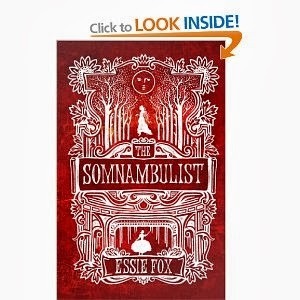 Essie Fox's Victorian Gothic Novel Somnambulist
Essie Fox's Victorian Gothic Novel SomnambulistAlso, I highly recommend you check out Essie Fox's Gothic novels because they are something really special and definite must reads for Halloween! Perfect for RIP VIII reading challenge!
Don't forget to enter to win the Halloween Giveaway, including one of two $25 Amazon Gift Cards and don't forget to sign up for my Free email series Insider Secrets on Authorship!
Find out what it’s really like to be a published author, experience the author process, and learn how it’s really done! Sign up for the free email series coming soon!
Here is a sneak peak of my guest post but you will need to visit Essie Fox's The Virtual Victorian to read the entire thing. Enjoy!
A Horror Story or a Message?
Charlotte Perkins Gilman’s story “The Yellow Wallpaper” was published in a magazine in the early 1890s. At first glance, many readers, both past and present, see a scary story of either a haunted house or a situation of pure insanity, both of which are elements of Gothic fiction. “The Yellow Wallpaper” is considered a part of the Victorian Gothic and horror genre, but it is much more than that.
The story was inspired by Gilman’s own experiences after seeking help for her “nervousness” and “melancholia” from the famous neurologist S. Weir Mitchell, who was known for his “rest cure”treatment for hysteria. Read what Charlotte Perkins Gilman herself said about her story “The Yellow Wallpaper.”
Historians now look to Gilman’s short story as one of the most revealing inside looks at the experience of a woman diagnosed and treated as a hysteric during the late nineteenth century. Since Gilman was also a feminist with very public ideas regarding her views, this work is also seen as a look into how feminism may have developed during a time when hysteria was being diagnosed on epidemic levels.
What was Hysteria to the Victorians?
Hysteria evolved out of Ancient Greece with theories regarding a woman’s uterus having the ability to wonder the body and affect the brain, an idea that prevailed into the nineteenth and early twentieth centuries. In fact the smelling salts Victorian women used to prevent themselves from swooning were believed to frighten the uterus away from that area of the body.
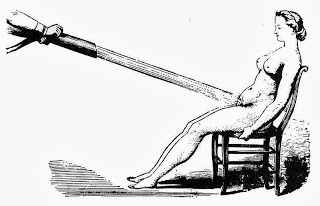
Throughout the century, hysteria was commonly associated with nervous or anxious tendencies such as fainting. However, by the late Victorian Era, there were a massive amount of symptoms associated with the condition known as hysteria, and women were diagnosed no matter how unique their actual situation. In many cases, men and women used it as an explanation for any kind of unwanted or erratic female behavior, especially emotional behavior.
There were also a wide variety of cures, including the rest cure (used in “The Yellow Wallpaper”), the water cure, vigorous exercise, vaginal stimulation*, hypnosis (Jean-Martin Charcot), and the beginnings of talk therapy and psychoanalytic analysis (Sigmund Freud). Due to Freud’s work, much of the research on hysteria has had an impact on modern psychology.
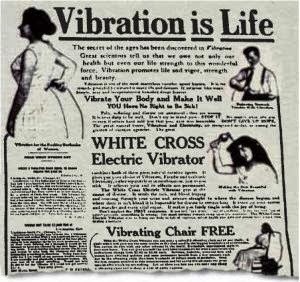
*A note on vaginal stimulation. Although many articles focus on the invention of the electric vibrator and the use to create a female orgasm as a treatment for hysteria, this was not the major impact of the hysterical movement on women or society. It did not contribute to any further understanding of female sexuality at the time. The idea of a woman being flawed if unable to climax through penetration prevailed even into the late twentieth century.
Hysteria and the Women’s Movement
In many ways the hysteria movement reflected and or embodied certain problems ...
Read the rest of the post on Essie Fox's The Virtual Victorian!
Published on October 19, 2013 12:45
Become a VIP Reader Today!
Sign Up Now!
1. Be the First to Know About Free-bees, Giveaways, and Discounts in addition to receiving Email List Only Deals and Prizes!
2. Read Behind the Scenes Material from Published & In-Progress Sign Up Now!
1. Be the First to Know About Free-bees, Giveaways, and Discounts in addition to receiving Email List Only Deals and Prizes!
2. Read Behind the Scenes Material from Published & In-Progress Books and Provide Feedback!
3. Get the Chance to Become a Test Reader and Receive an Advanced Copy for Free!
4. Be the First to Know About New Releases!
5. Learn more about me and my books, while also learning the how-tos of writing and publishing through my experiences.
Sign Up Now!
Email Address
...more
1. Be the First to Know About Free-bees, Giveaways, and Discounts in addition to receiving Email List Only Deals and Prizes!
2. Read Behind the Scenes Material from Published & In-Progress Sign Up Now!
1. Be the First to Know About Free-bees, Giveaways, and Discounts in addition to receiving Email List Only Deals and Prizes!
2. Read Behind the Scenes Material from Published & In-Progress Books and Provide Feedback!
3. Get the Chance to Become a Test Reader and Receive an Advanced Copy for Free!
4. Be the First to Know About New Releases!
5. Learn more about me and my books, while also learning the how-tos of writing and publishing through my experiences.
Sign Up Now!
Email Address
...more
- Stephanie Carroll's profile
- 30 followers



